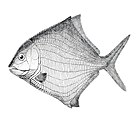Acrolepis
| Acrolepis Temporal range:
| |
|---|---|

| |
| Fossil of Acrolepis sedgwicki | |
| Scientific classification | |
| Kingdom: | Animalia
|
| Phylum: | Chordata
|
| Class: | |
| Order: | |
| Family: | |
| Genus: | †Acrolepis Agassiz, 1843
|
| Type species | |
| †Acrolepis sedgwicki Agassiz, 1843
| |
| Other species | |
| |
Acrolepis (Ancient Greek for "tip scale") is an extinct genus of prehistoric bony fish that lived from the Tournaisian stage of the Mississippian (early Carboniferous) to the late Permian epoch.[1] Some species from the Early Triassic of Tasmania are also ascribed to Acrolepis.
It is a large piscivorous predatory fish in the acrolepid family, which occupy an apex predator niche in its locale. Measured from the fossil specimen discovered in Germany, the species was estimated to have grown up to 3 metres (9.8 ft) in length, making it one of the largest predatory fish of the Tournaisian and Permian.
A close relationship between the mostly Palaeozoic Acrolepidae and the Mesozoic Ptycholepiformes was proposed, but support from phylogenetic analyses is scarce.[4]

Diet[]
Acrolepis pursued a wide range of small fish (most primarily Palaeonisciformes), sarcopterygans, ammonoids, crustaceans, small eurypterids, bivalves and other tiny invertebrates. It used its teeth similarly to the extant pike, holding slippery, scaly prey in place and pulling edible material into smaller pieces for whole consumption. It was a solitary hunter, relying on its size alone to overcome prey, and be the sole individual to consume prey. Natural threats to this creature were minimal, as other predatory creatures larger than itself (such as Sarcoprion, a eugeneodontid of the same period) were heavily isolated and distanced from this creature, allowing it free rein in its environment.[5]
Fossil record[]
The type species is Acrolepis sedgwicki from the late Permian Marl Slate of England and the coeval Kupferschiefer of Germany. Other species are known from Carboniferous and Permian rocks in the Czech Republic and Triassic layers of Tasmania.
Specimens in possession of Tyne & Wear Archives and Museums comprise a fossilized jawbone from the Marl Slate of Durham Province.
Synonyms[]
- † Woodward, 1912 → †Boreosomus acticus
- † Woodward, 1891 → †
- † Lambe, 1916 → †Pteronisculus? laetus

Other[]
The coat of arms of the village and municipality of Žilov, Plzeň-North District in the Plzeň Region of the Czech Republic, features a restoration of Acrolepis gigas in the center of the black-silver-red divided shield.
See also[]
- Prehistoric fish
- List of prehistoric bony fish
References[]
- ^ a b Sepkoski, Jack (2002). "A compendium of fossil marine animal genera". Bulletins of American Paleontology. 363: 1–560. Archived from the original on 2011-07-23. Retrieved 2009-04-24.
- ^ Romano, Carlo; Koot, Martha B.; Kogan, Ilja; Brayard, Arnaud; Minikh, Alla V.; Brinkmann, Winand; Bucher, Hugo; Kriwet, Jürgen (February 2016). "Permian-Triassic Osteichthyes (bony fishes): diversity dynamics and body size evolution". Biological Reviews. 91 (1): 106–147. doi:10.1111/brv.12161. PMID 25431138. S2CID 5332637.
- ^ "Acrolepidae". Paleobiology Database. Retrieved November 17, 2012.
- ^ Mutter, Raoul (2011). "A case study of the palaeobiogeography of Early Mesozoic actinopterygians, the family Ptycholepidae.". In Upchurch, P.; McGowan, A.J.; Slater, C.S.C. (eds.). Palaeogeography and Palaeobiogeography: Biodiversity in Space and Time. CRC Press, Boca Raton. pp. 143–171.
- ^ http://www.twmuseums.org.uk/geofinder/search/item.php?record=NEWHM:2004.H61[permanent dead link] Geofinder Marl Slate, Record Number: NEWHM:2004.H61
- Mississippian fish
- Palaeonisciformes
- Prehistoric ray-finned fish genera
- Permian bony fish
- Triassic fish
- Triassic bony fish
- Fossils of Germany
- Triassic fish stubs
- Palaeonisciformes stubs







